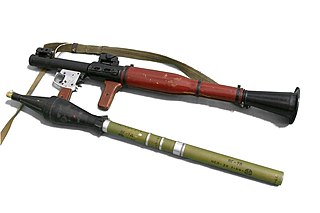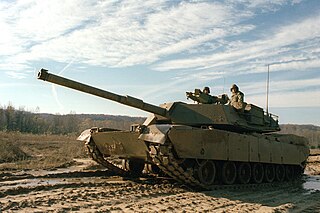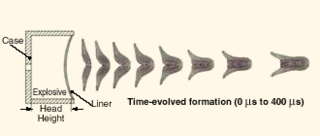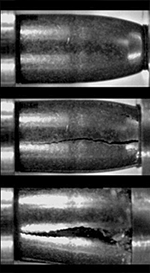Related Research Articles

A rocket-propelled grenade is a shoulder-fired missile weapon that launches rockets equipped with an explosive warhead. Most RPGs can be carried by an individual soldier, and are frequently used as anti-tank weapons. These warheads are affixed to a rocket motor which propels the RPG towards the target and they are stabilized in flight with fins. Some types of RPG are reloadable with new rocket-propelled grenades, while others are single-use. RPGs are generally loaded from the front.

A shaped charge is an explosive charge shaped to focus the effect of the explosive's energy. Different types of shaped charges are used for various purposes such as cutting and forming metal, initiating nuclear weapons, penetrating armor, or perforating wells in the oil and gas industry.

A kinetic energy penetrator is a type of ammunition designed to penetrate vehicle armour using a flechette-like, high-sectional density projectile. Like a bullet, this type of ammunition does not contain explosive payloads and uses purely kinetic energy to penetrate the target. Modern KEP munitions are typically of the armour-piercing fin-stabilized discarding sabot (APFSDS) type.

A micrometeoroid is a tiny meteoroid: a small particle of rock in space, usually weighing less than a gram. A micrometeorite is such a particle that survives passage through Earth's atmosphere and reaches Earth's surface.

Chobham armour is the informal name of a composite armour developed in the 1960s at the British tank research centre on Chobham Common, Surrey. The name has since become the common generic term for composite ceramic vehicle armour. Other names informally given to Chobham armour include "Burlington" and "Dorchester". "Special armour" is a broader informal term referring to any armour arrangement comprising "sandwich" reactive plates, including Chobham armour.

High-explosive anti-tank (HEAT) is a type of shaped charge explosive that uses the Munroe effect to penetrate heavy armor. The warhead functions by having an explosive charge collapse a metal liner inside the warhead into a high-velocity superplastic jet; this is capable of penetrating armor steel to a depth of seven or more times the diameter of the charge. The jet's effect is purely kinetic in nature; the round has no explosive or incendiary effect on the target.

Spall are fragments of a material that are broken off a larger solid body. It can be produced by a variety of mechanisms, including as a result of projectile impact, corrosion, weathering, cavitation, or excessive rolling pressure. Spalling and spallation both describe the process of surface failure in which spall is shed.

An anti-materiel rifle (AMR) is a rifle designed for use against military equipment (materiel), rather than against humans ("anti-personnel"). They are designed to employ high-caliber or explosive rounds that can destroy vehicles such as tanks and armored troop transports. Their effectiveness has declined since the world wars as vehicle armor has improved. In modern warfare, their main use is to destroy lightly armored vehicles, structures, and unexploded munitions.

Ejecta are particles ejected from an area. In volcanology, in particular, the term refers to particles including pyroclastic materials (tephra) that came out of a volcanic explosion and magma eruption volcanic vent, or crater, has traveled through the air or under water, and fell back on the ground surface or on the ocean floor.
Ablative armor is armor which prevents damage through the process of ablation, the removal of material from the surface of an object by vaporization, chipping, or other erosive processes. In contemporary spacecraft, ablative plating is most frequently seen as an ablative heat shield for a vehicle that must enter atmosphere from orbit, such as on nuclear warheads, or space vehicles like the Mars Pathfinder probe. A large amount of developmental usage was on the early 1960s rocket powered X-15 crewed aircraft traveling at hypersonic speeds in excess of Mach 6.5. The idea is also commonly encountered in science fiction. In recent years, the concept has had widespread usage in robot combat as a method of reducing impact energy transfer to vital components.

The Whipple shield or Whipple bumper, invented by Fred Whipple, is a type of hypervelocity impact shield used to protect crewed and uncrewed spacecraft from collisions with micrometeoroids and orbital debris whose velocities generally range between 3 and 18 kilometres per second. According to NASA, the Whipple shield is designed to withstand collisions with debris up to 1 cm, which helps to mitigate the Kessler syndrome.

Military vehicles are commonly armoured to withstand the impact of shrapnel, bullets, shells, rockets, and missiles, protecting the personnel inside from enemy fire. Such vehicles include armoured fighting vehicles like tanks, aircraft, and ships.

Eye protection is protective gear for the eyes, and sometimes face, designed to reduce the risk of injury. Examples of risks requiring eye protection can include: impact from particles or debris, light or radiation, wind blast, heat, sea spray or impact from some type of ball or puck used in sports.
Space environment is a branch of astronautics, aerospace engineering and space physics that seeks to understand and address conditions existing in space that affect the design and operation of spacecraft. A related subject, space weather, deals with dynamic processes in the solar-terrestrial system that can give rise to effects on spacecraft, but that can also affect the atmosphere, ionosphere and geomagnetic field, giving rise to several other kinds of effects on human technologies.

Hypervelocity is very high velocity, approximately over 3,000 meters per second. In particular, hypervelocity is velocity so high that the strength of materials upon impact is very small compared to inertial stresses. Thus, metals and fluids behave alike under hypervelocity impact. Extreme hypervelocity results in vaporization of the impactor and target. For structural metals, hypervelocity is generally considered to be over 2,500 m/s. Meteorite craters are also examples of hypervelocity impacts.

An explosively formed penetrator (EFP), also known as an explosively formed projectile, a self-forging warhead, or a self-forging fragment, is a special type of shaped charge designed to penetrate armor effectively. As the name suggests, the effect of the explosive charge is to deform a metal plate into a slug or rod shape and accelerate it toward a target. They were first developed as oil well perforators by American oil companies in the 1930s, and were deployed as weapons in World War II.
The physicist Sir Isaac Newton first developed this idea to get rough approximations for the impact depth for projectiles traveling at high velocities.

Frangible bullets are intended to disintegrate into tiny particles upon target impact to minimize their penetration of other objects. Small particles are slowed more rapidly by air resistance, and are less likely to cause injury or damage to persons and objects distant from the point of bullet impact.

Armor-piercing fin-stabilized discarding sabot (APFSDS), long dart penetrator, or simply dart ammunition, is a type of kinetic energy penetrator ammunition used to attack modern vehicle armor. As an armament for main battle tanks, it succeeds Armor-Piercing Discarding Sabot (APDS) ammunition, which is still used in small or medium caliber weapon systems.
Liquid Armour is a material under research by defense institutions and universities around the world including the United States Army Research Laboratory (ARL). Some of the earliest research in this area was performed at Massachusetts Institute of Technology and University of Delaware in 2003. Liquid armor was initially presented as a way to increase the survivability of soldiers in high risk roles while retaining their mobility, as reported by NPR in an interview with MIT professors and a U.S. admiral.
References
- 1 2 B. Pedersen, S Bless. (2006). "Behind-armor debris from the impact of hypervelocity tungsten penetrators". International Journal of Impact Engineering. 33 (1–12): 605–614. doi:10.1016/j.ijimpeng.2006.09.007.